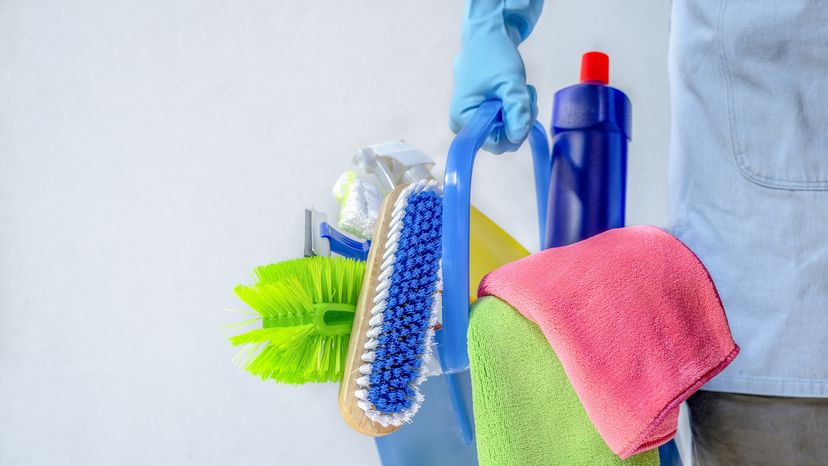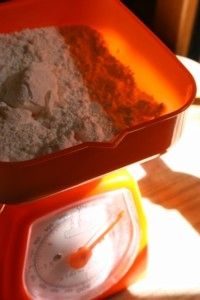The chemicals in this section can help you get rid of those nasty household and laundry stains when properly used.
Acetic Acid. A 10% solution of acetic acid can be purchased generically at pharmacies. (White vinegar is 5% acetic acid and can be used as a substitute for the stronger solution.) It is a clear fluid that can be used to remove stains on silk and wool. It must be diluted with 2 parts water for use on cotton and linen (a pretest is recommended). It should not be used on acetate. If acetic acid causes a color change, sponge the affected area with ammonia.
Acetone. Acetone can be purchased generically at pharmacies and hobby shops. A colorless liquid that smells like peppermint, it can be used on stains caused by substances such as fingernail polish or household cement. Although it will not damage either natural fibers or most synthetics, it should be pretested to make sure that dyed fabrics will not be harmed. It should not be used on fabrics containing acetate. Use only pure acetone on stains; although most nail polish removers contain acetone, the other ingredients included in these products can worsen stains. Caution: Acetone is flammable and evaporates rapidly, producing toxic fumes. When using acetone, work outside or in a well-ventilated place. Avoid inhaling fumes. Store in a tightly capped container in a cool place.
Alcohol. Common isopropyl alcohol (70%), which can be purchased generically at drugstores, is sufficient for most stain-removal jobs that call for alcohol, although the stronger denatured alcohol (90%) can also be used. Be sure you don't buy alcohol with added color or fragrance. Alcohol will fade some dyes; pretest before using it. Alcohol will damage acetate, tri acetate, modacrylic, and acrylic fibers. If you must use it on fibers in the acetate family, dilute the alcohol with two parts water. Caution: Alcohol is poisonous and flammable. Observe all label precautions.
Ammonia. For stain removal, purchase plain household ammonia without added color or fragrance. It is sold at grocery stores. Because ammonia affects some dyes, always pretest on a hidden corner of the stained article. To restore color changed by ammonia, rinse the affected area with water and apply a few drops of white vinegar. Rinse with clear water again. Ammonia damages silk and wool; if you must use it on these fibers, dilute it with an equal amount of water and use as sparingly as possible. Caution: Ammonia is poisonous. Avoid inhaling its fumes. It will cause burns or irritation if it comes in contact with the skin or eyes. Observe all label precautions. Never mix ammonia with chlorine bleach, as this will release chloramine, a highly toxic substance.
Amyl Acetate. Buy chemically pure amyl acetate (banana oil) for use in stain removal. It is sometimes available at drugstores or may perhaps be ordered from them. It is safe for use on fibers that could be damaged by acetone, but it should not be allowed to come in contact with plastics or furniture finishes. Caution: Amyl acetate is poisonous and flammable. Avoid contact with the skin and inhaling the vapors.
Coconut Oil. Coconut oil is sold in drug and health food stores. It is used in the preparation of a dry spotter, which is used to remove many kinds of stains. If you cannot obtain coconut oil, you may substitute mineral oil which is almost as effective.
Glycerine. Glycerine is sold generically in pharmacies. It is used in the preparation of the wet spotter, which is used to remove many kinds of stains.
Oxalic Acid. Effective in treating ink and rust stains, oxalic acid crystals may be found in pharmacies or special-ordered from them. Before using the crystals, you must dissolve them in water (1 tablespoon crystals to 1 cup warm water). You may also be able to purchase liquid oxalic acid at hardware stores, where it is sometimes sold as wood bleach. Pretest the solution on a hidden corner before using it on the stain. Moisten the stained area with the solution. Allow to dry, then reapply, keeping the area moist until the stain is removed. Be sure all traces of the solution are rinsed out. Caution: Oxalic acid is poisonous. Avoid all contact with the skin and eyes and wear rubber gloves and other protective clothing when working with it.
Sodium Thiosulfate. Sometimes available in crystal form at drugstores and photo supply houses, sodium thiosulfate is also known as photographic "hypo" or fixer. Although considered safe for all fibers and harmless to dyes, it should be tested on an inconspicuous area of fabric before use. Handle carefully, as sodium thiosulfate can cause irritation to the eyes, skin, lungs and digestive tract.
Turpentine. Turpentine is commonly found in paint and hardware stores and in art supply houses. Most often used as a thinner for oil-base paints, it is effective on paint and grease stains, but it must be used carefully. Caution: Turpentine is flammable and poisonous. Observe all label precautions.
Vinegar. Only white vinegar should be used for stain removal. Cider and wine vinegar have color that can leave a stain. Vinegar can be purchased at grocery stores and pharmacies. It contains a 5% acetic acid solution and should be diluted if you must use it on cotton or linen. Vinegar is safe for all other colorfast fibers, but can change the color of some dyes, so always test its effects on an inconspicuous area first. If a dye changes color, rinse the affected area with water and add a few drops of ammonia. Rinse thoroughly with water again.
Learn about dry-cleaning solvents in the next section.

